Abstract
We indicate that Heron’s formula (which relates the square of the area of a triangle to a quartic function of its edge lengths) can be interpreted as a scissors congruence in four-dimensional space. In the process of demonstrating this, we examine a number of decompositions of hypercubes, hyper-parallelograms and other elementary four-dimensional solids.1. Introduction
Heron’s formula gives the explicit relationship among the area, A, of a triangle and its edge lengths [1]. We assume, now and throughout, that a triangle with edge lengths, a, b, c, where 0 < a ≤ b ≤ c, is given. The semi-perimeter is the quantity: S = (a + b + c)/2. One representation of the formula is:
The formula was written in Heron’s (Hero’s) book Metrica circa 60 AD. According to Wikipedia [2], the formula may have been known to Archimedes more than two centuries earlier. However, Heron’s book was a compendium of a number of known results. Here, we square both sides of the equation and multiply by the denominator to get the following expression:
This can be considered an expression that relates the four-dimensional volumes of a number of hyper-solids. As the text develops, we will further manipulate this expression all the while maintaining a four-dimensional awareness of the algebraic manipulations that are performed.
Our primary purpose here is to indicate a four-dimensional scissors congruence among the hyper-solids that are involved in Heron’s formula. However, in the process, we will also develop several secondary goals along the way. These are our own interpretations of conversations with several people. Most importantly, we hope to develop the reader’s intuition and interest in elementary four-dimensional geometry.
In particular, many algebraic identities, such as the binomial and multinomial theorems, have elegant and useful interpretations in terms of relating the higher dimensional volumes of various n-cubes. The symmetries in the expressions are manifest in the symmetries among the pieces of these decompositions.
We remark here that the algebraic proof of Heron’s formula given in this form goes as follows. Suppose that we arrange the triangle in the coordinate plane as indicated in Figure 1.
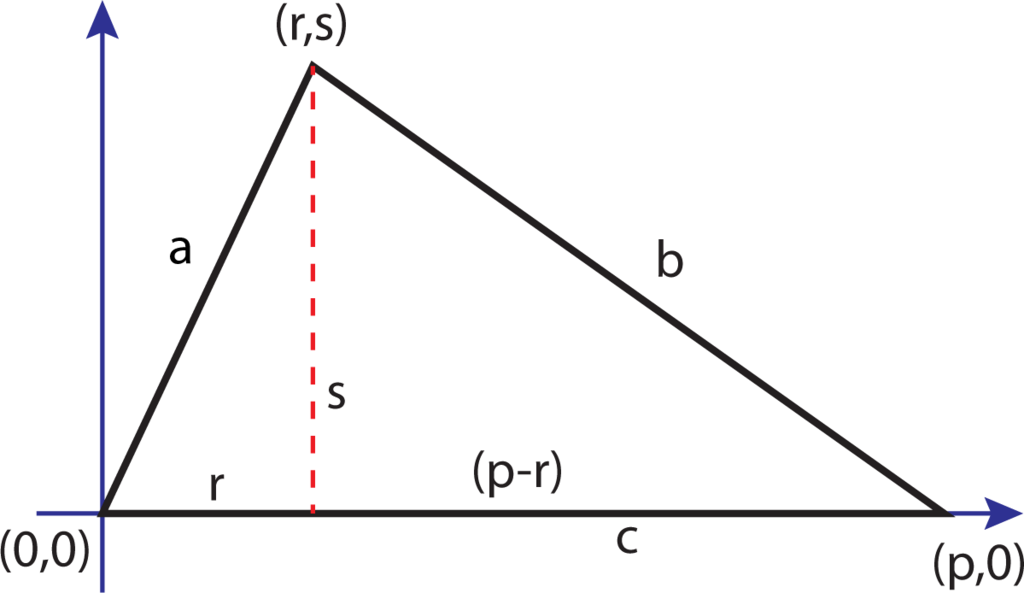
In this way, one vertex is at the origin; the longest side (the side of length c) lies along the x-axis with a vertex at the point (p, 0) (here, a different coordinate is chosen, so that the new variables are of the same flavor). The remaining vertex lies at the point (r, s). In this way, a2 = r2 + s2 and b2 = s2 + (p − r)2. The left-hand-side of Heron’s formula can be shown to be 4p2s2. The right-hand-side reduces to:
We expand the terms on the right-hand-side as follows:
We cancel like terms:
After regrouping:
We factor the last line:
As such, the formula has been proven. However, we point out that even in our most quiet moments, the simplification:
In Section 2, we discuss the n-cube from several points of view, including its representation as a configuration space. Then, we decompose it into right n-dimensional simplices. This decomposition gives Nicomachus’s theorem [3]. Our interpretation yields that the cube [0, a]4 can be decomposed as the union of four congruent figures, each of the form of a right isosceles triangle times itself. In Section 3, we discuss the multinomial theorem as another decomposition of the n-cube, and we use this idea to organize the computation of the right-hand side of Heron’s formula. In Section 4, we demonstrate that the proof of the Pythagorean theorem can be adjusted to a proof of a four-dimensional result: if z2 = x2 + y2 and u2 + v2 = w2, then the hyper-cube [0, z] × [0, z] × [0, w] × [0, w] can be cut into 25 pieces that can be reassembled into a figure that is the product of a pair of sums of squares. This is the geometric interpretation of the identity:
In Section 5, we tie up some loose ends in the algebraic proof above. Section 6 discusses the left-hand-side of the equation, and Section 7 is a conclusion.
2. The n-Dimensional Cube
From a mathematician’s perspective, the n-dimensional unit cube is a very natural object. It is written as [0, 1]n and can be considered as the set of functions from {1, 2,…, n} to the unit interval. A given function is determined by its set of values, and these are expressed as coordinates (x1, x2,…, xn), where xj is the value of a given function on j ∈ {1, 2,…, n}. For j = 1, 2,…, n, each xj is bounded between zero and one. We occasionally write 0 ≤ x1, x2,…, xn ≤ 1 to indicate the collection of such relations. In the rest of this section, we develop a number of metaphors, so that different intuitions can be developed.
2.1. Fingers
Before we consider the unit n-cube in general, let us consider binary digits: your fingers, each in one of two possible states. Hold up your right hand, and make a fist. Now, sequentially start from your thumb and proceed through each of the remaining digits. Hold up your thumb as if hitch-hiking or simply giving a “thumbs-up”; retract it. Now, hold up your index finger, and retract it. Do so with each of your middle, annular and your baby finger (pinky). Hold up some pair of fingers. In how many ways can two fingers be held up (10)? How many ways can you hold up three fingers (again, 10)? How about four fingers (five)?
These are digits since they are fingers. They are binary since they are either up or down. Assign the number 20 = 1 to your thumb; assign 21 = 2 to your index finger; assign 22 = 4 to your middle finger; assign eight to your ring finger; and assign 16 to your pinky. When you consider all possible finger configurations on one hand, you can see that you can represent each integer from zero to 31 as the sum of the values of the upheld fingers in each finger configuration.
In Figure 2, we have arranged the first eight of these configurations at the vertices of a cube in three-dimensional space.
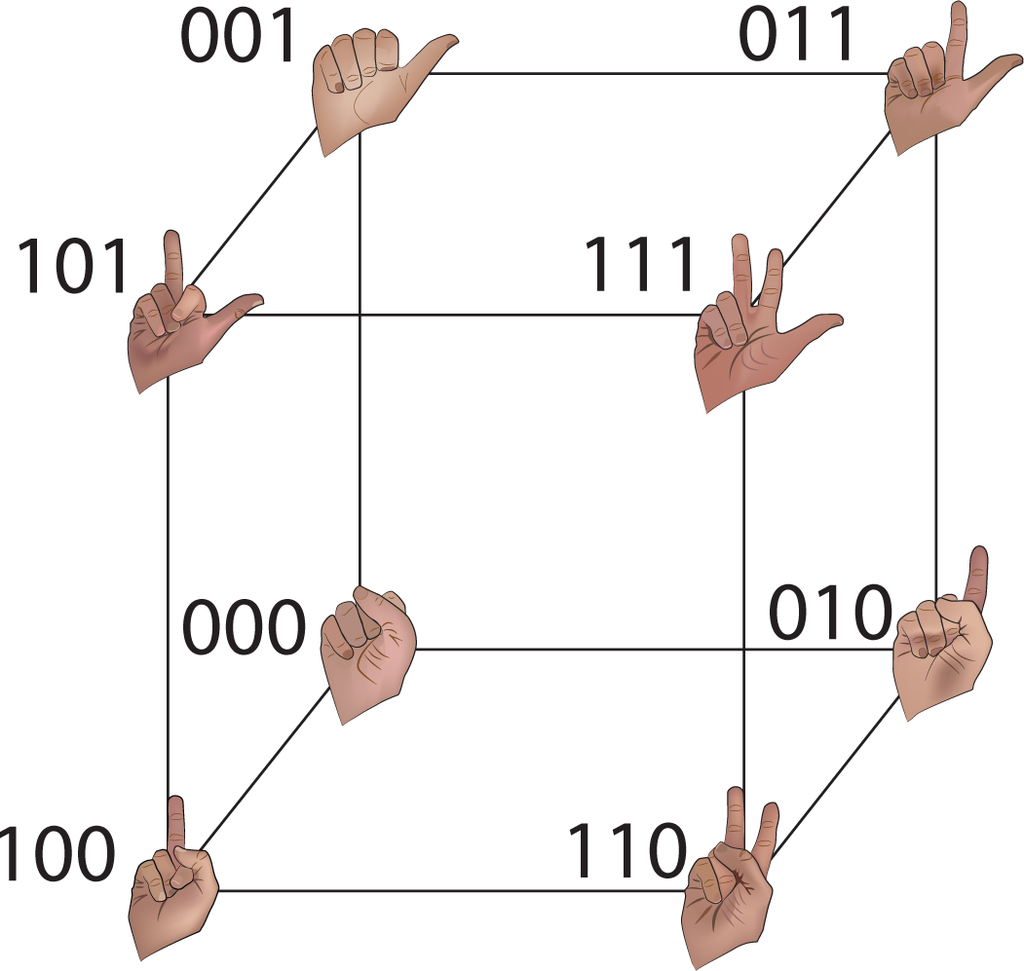
In returning to the description of the unit n-dimensional cube as [0, 1]n—the set of functions from {1,…, n} into the unit interval—we observe that the binary sequences are the extreme values of such functions: xj = 0 or xj = 1 for each j = 1,…, n.
2.2. Kitchen Drawers
Imagine a small kitchen that has exactly four drawers. Each drawer can be open or closed. As such, we can describe the state of the kitchen cabinet as a binary sequence. However, let us suppose that each drawer can be open any distance from zero cubits up to fully open at a cubit. By convention, a cubit is roughly half a meter. The units are chosen to appear to be realistic from the point of view of a kitchen. Let us label the drawers with integers one through four. Then, the configurations of the set of drawers corresponds to a function from {1, 2, 3, 4} into [0, 1]. Therefore, the possible states for this kitchen cabinet correspond to the points of a four-dimensional cube. We call this cube the hypercube.
2.3. An Archive
It is easy to generalize from the kitchen cabinet to a large archive in a bureaucracy. This archive has a large number of cabinets, say n of them. Each cabinet consists of a single drawer. The cabinets lie along the south wall of a building and are numbered east-to-west from one through n. The drawers can open up to a full meter. Therefore, the set of possible configurations of the cabinets corresponds to the unit n-dimensional cube [0, 1]n, since if xj is the distance (in meters) that the j-th drawer is open, then 0 ≤ xj ≤ 1. The configuration of any one drawer is independent of the configuration of all other drawers.
We begin this subsection with a simple case. Consider the possible configurations of a pair of drawers. Let x denote the distance that the first drawer is opened, and let y denote the distance that the second drawer is opened. Of course, 0 ≤ x, y ≤ 1, that is each drawer can be opened any amount from zero meters to one meter. This situation can be subdivided into two cases. Either the drawer on the left is no more open than the drawer on the right is, or vice versa. Thus, either 0 ≤ x ≤ y ≤ 1 or 0 ≤ y ≤ x ≤ 1. These cases are not disjoint; their coincidence occurs when both drawers are equally open: x = y. The set of all configurations of the drawers corresponds to a unit square. We have decomposed the square as the union of two isosceles right triangles whose legs are a unit length. They intersect along their diagonals.
For example, the point (1/4, 1/2) in the unit square corresponds to the configuration in which the drawer on the left is open half as much as the drawer on the right, which is half-open. See Figure 3.
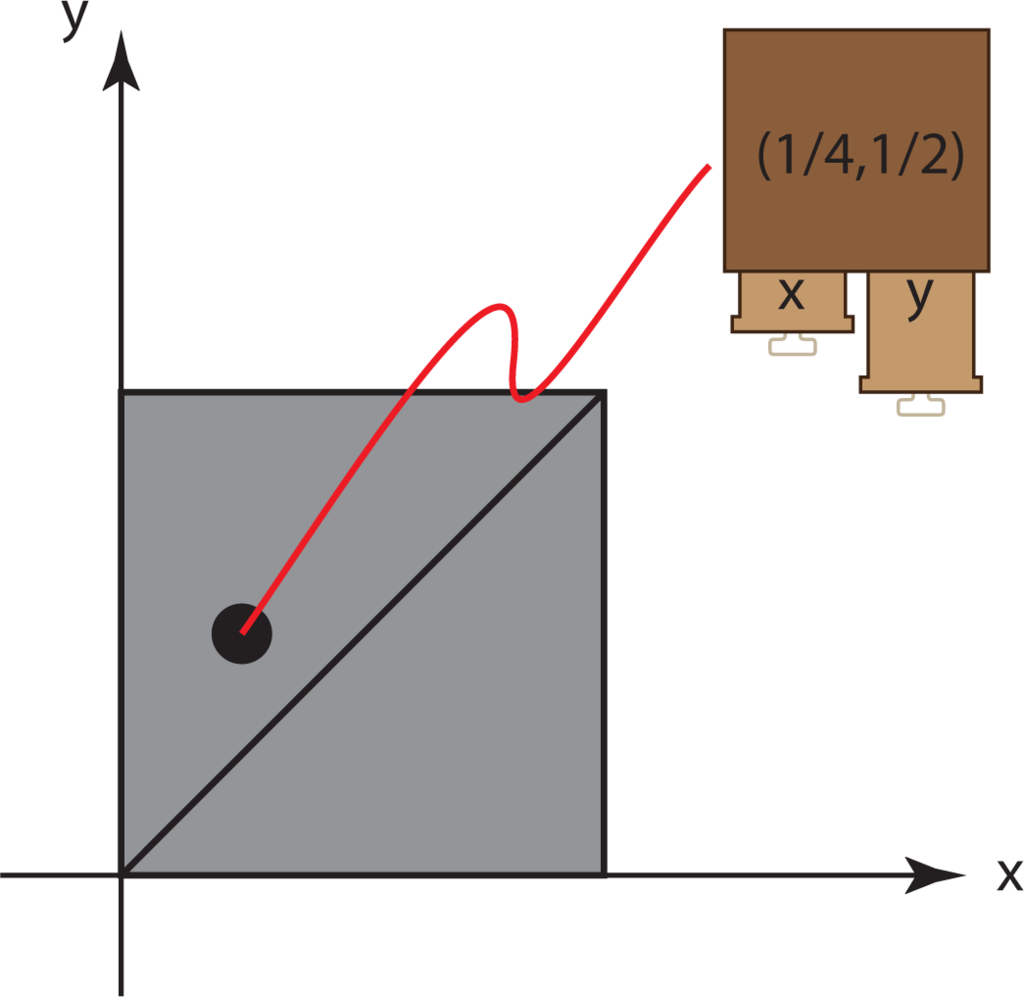
2.4. Triangles, Tetrahedra, and So Forth
Now, consider three drawers. Let x, y and z denote the amount that each is pulled out. As before, 0 ≤ x, y, z ≤ 1, but there is no relation among the openness of the drawers in general. We decompose this situation into six configurations:
In full generality, we have n drawers with drawer number j open to a distance xj. In this case, 0 ≤ x1, x2,…, xn ≤ 1. There are n! = n(n − 1)! (where 0! = 1) possible orderings of the distances that the drawers can be open. To see this, observe that the j-th drawer may be pulled out a greater distance than all of the others. Thus, there are n possible ways for one drawer to be more extended than all of the rest. By induction, the remaining (n − 1) drawers are ordered in (n − 1)! configurations.
A right n-dimensional simplex consists of the point set:
The n-dimensional cube can be decomposed into n! such simplices that are all congruent. Therefore, the n-dimensional volume of such a simplex is .
There is a typographical trick called the L7-trick (cf. the second verse to Woolly Bully as sung by Sam the Sham and the Pharaohs), to obtain the set of vertices for each simplex. Let n be fixed. Consider a row of n 0s (separated, if you like, by commas): 00…0. Furthermore, construct a column of n 1s. Now, the column of 1s can be appended below any one of the 0s. Thus, there are n possible ways of doing so. For each such shape, we can insert the (n − 1)! shapes that exist by induction. The first step of the induction is to consider the array . In the next step, we have the arrays:
The rows are the coordinates of the vertices of the two triangles 0 ≤ x ≤ y ≤ 1 and 0 ≤ y ≤ x ≤ 1 into which the unit square was decomposed. For the cube, we start from the three arrays:
In the next step, each of these six matrices are fed into the four patterns:
The resulting rows of each matrix are the five vertices of each four-simplex. The union of these fills the four-cube. The situations are illustrated in Figure 5. In this figure, six copies of each three-dimensional cube x = 1, y = 1, z = 1 and w = 1 are illustrated. In each such cube, a tetrahedron is drawn, and this is to be coned to the origin in the figure. The rows of the matrices that appear to the left of each hypercube indicate the coordinates of the vertices of the four-simplices, which are drawn as small purple spheres.
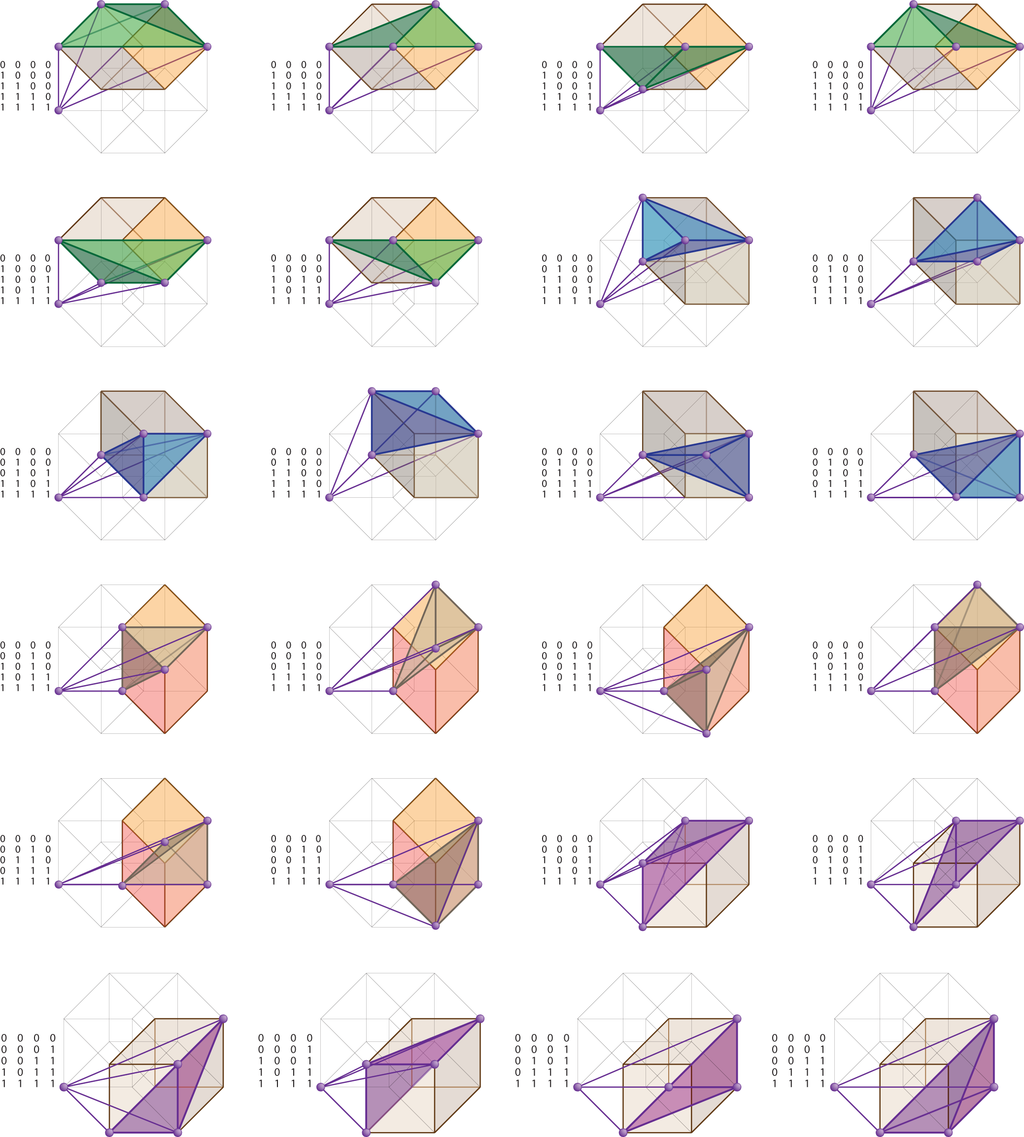
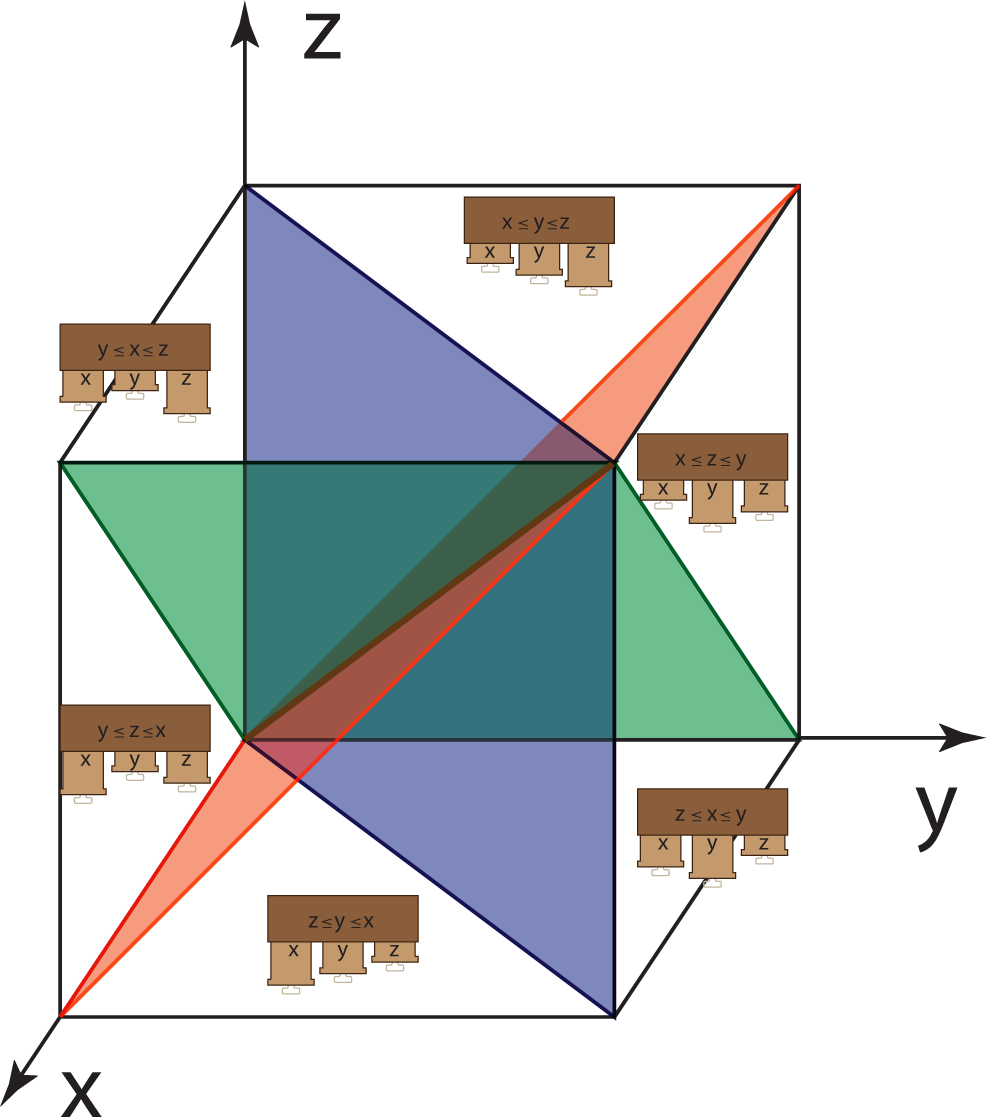
2.5. Pyramidal Sets
In the unit n-cube, [0, 1]n consider the set:
For any fixed value xn = C, the cross-sectional set {(x1,…, xn−1, C) : 0 ≤ xj ≤ C} is an (n − 1)-dimensional cube [0, C]n−1 whose volume (we will use the term volume to mean n-dimensional volume) then is Cn−1.
Considering the situation of drawers, we can imagine a “high priority drawer”, which can be opened any distance between zero and one meters. If it is opened to C meters, then the remaining drawers can only be opened that far. Alternatively, we can imagine an alternative situation in which a king or queen (sovereign) is seated in one of n-chairs. All of the subjects are also seated, and no one is to stand taller than the sovereign. As the sovereign stands, all of the inferiors attempt to stand. The set of configurations of partially standing people corresponds to the configurations of partially opened drawers and of the points in the pyramidal set Pn. Here, note that the subscript n on the expression Pn indicates that the last coordinate is the position of the sovereign.
More generally, let:
Observe that the n-cube is decomposed into n congruent pyramids. One can then interpret this decomposition as a geometric manifestation of the fact that:
This interpretation was given in [4] and earlier in [5].
2.6. The Cone on a Cube Is a Square of a Triangle
A favorite formula from discrete mathematics is Nicomachus’s theorem:
One usually proves this by induction. Since:
Dylan Thurston pointed out to the first named author that one could consider the formula continuously. Thus, the four-dimensional figure that is a cone on a cube has the same four-dimensional volume as the square of a triangle. Dylan’s argument was developed over a dinner that he had with Dave Bayer and Walter Neumann. This section presents our modification of another dinner-time description that was given by Dror Bar-Natan in Hanoi on some evening in the period of 6–12 August 2007.
First, we consider the product of a right isosceles triangle with itself. This will be:
As a configuration of drawers, the first drawer is no more open than the second, while the third drawer is no more open than the fourth. Alternatively, we consider a pair of married couples in which neither husband speaks more than his own wife, but either husband may speak more than the wife of the other.
Now, the hypercube [0, 1]4 can be decomposed into four congruent figures:
See Figure 6 for an illustration.

Additionally, it also can be decomposed into the four pyramidal sets:
Now, we decompose, Δx≤y × Δz≤w into six four-simplices in which:
Observe that a four-cube of the form [0, a]4 also can be cut into the union of four figures each of which is the product of two isosceles right triangles of edge length a, a and . This decomposition is considered as a special case of Heron’s formula, for in this case a = b and c = . The right-hand side reduces to 4a4. Therefore, sixteen copies of a right isosceles triangle times itself are reassembled into four hyper-cubes.
3. The Distributive Law, the Multinomial Theorem and Scissors Congruences
Two n-dimensional polyhedra are said to be scissors congruent if and only if they each can be cut into a union of congruent polyhedra. For the example above, we demonstrated that the n-cube is scissors congruent to a union of right n-simplices, and we demonstrated a scissors congruence between the product of a right isosceles triangle and itself with the cone on a cube. In this paper, we are primarily concerned with four-dimensional figures that are hypercubic, cones on three-dimensional polyhedra and the two-fold product of polygons.
Famously, Max Dehn [6,7] demonstrated that a regular tetrahedron of unit volume is not scissors congruent with a unit cube.
To begin this section, in which an n-dimensional cube with variable edge lengths is decomposed into several smaller sub-cubes, we first consider the case n = 1.
A line segment whose length is the sum x + y of two positive quantities x and y can be cut into two segments with the segment of length x on the left and the segment of length y on the right (or vice versa). Similarly, suppose that x < y and a segment of length y − x is given. It could be produced by means of cutting a segment of length x from the longer segment. Of course, we can, in general, discuss directed segments with the direction “right” indicating positive length quantities and the direction “left” used to indicate negative quantities. In this way, each of x + y, x − y and y − x can be thought of as being built by composing directed segments of lengths x and y. It is conceptually easier to think in this fashion rather than explicitly removing segments and hypercubes whose total volumes in algebraic expressions happen to be negative.
In the case that a given rectangular area of dimensions (x + y)-by-z can be decomposed as a pair of rectangular areas x-by-z and y-by-z, as above, we can indicate (x − y)z as the difference between areas xz and yz. We further exploit the distributive law as a scissors congruence when considering the case (x + y)-by-(z + w). This rectangular area is decomposed as the union of four rectangles of size xz, xw, yz and yw. Some of these scissors congruences are indicated in Figure 7. We leave the reader to imagine others.
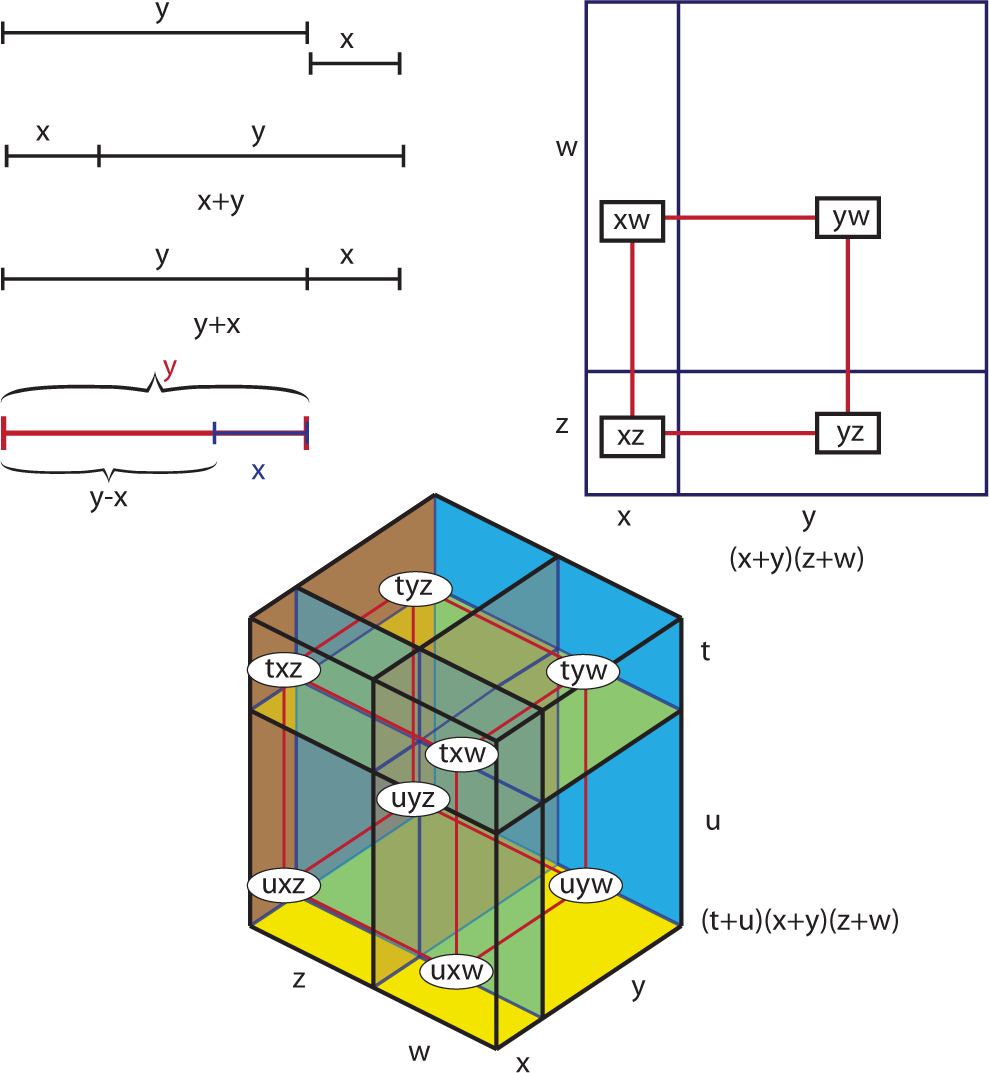
For convenience within cubes, hypercubes and beyond, we dualize the pictures by indicating a vertex with a label that indicates its volume (and is drawn red if the net volume is negative) and connecting these by an edge if they share a codimension one face. If they share a codimension two face, then the dual vertices will bound a polygon (always a rectangle in our cases), and so forth. The language of shared polygonal vertices, edges, faces, and so forth, is initially quite awkward (thus, the term “codimension” is used), but in our case, the situation is a bit more straight-forward than one might presume.
Our main interest here is to consider the n-dimensional cube that is decomposed as a product of edges in the form:
This expression RH is called the right-hand side of Heron’s formula. When we use the distributive law to expand the product as the union of 81 hypercubes (more precisely, hyper-rectangles), we want to identify which terms will cancel. It is not terribly difficult to determine that the product reduces to:
“Not terribly difficult” is a relative phrase. An electronic computer can do so easily; a human has to develop some technique to organize and regroup the 81 terms that are initially involved in the expansion. Our purpose here will be to find within the hyper-solid the location of each piece. We will observe that the pieces that cancel can be found on specific affine three-dimensional planes.
To help determine the addresses of the vertices in the dual complex, we will examine the terms in the multinomial expansion:
This situation is more general in that we are considering an n-dimensional quantity, but it is too specific for the case at hand, since the terms in the expansion of RH involve differing edge lengths. Still, once the addressing problem is solved for the multinomial expansion, it will be easy to apply here.
The quantity corresponds to decomposing into k pieces. The volumes of each piece are a product of xis, where each xi is taken from one factor of the decomposition of the edges of the n-cube. Thus, there is a specific n-cube (The correct terminology might be n-rectangle, since the edge lengths vary. Here, we will use the more concise terminology, but elsewhere, we may speak of “hyper-rectangles”.) of volume , where each iℓ ∈ {1,…, k}, and this ℓ-th factor was selected from the ℓ-th factor in the product expansion:
In order to keep track of these terms, we consider the coordinates of the points in the integral lattice that lie within the cube [0, (k − 1)]n. These coordinates range between (0, 0,…, 0) and (k − 1, k − 1,…, k − 1). We then label the point (i1 − 1, i2 − 1,…, in − 1) in the integral lattice with the term in the expansion above.
The next step in understanding the multinomial theorem is to count all of the terms that have the same volume as the cube does. Therefore, we can think of as a multi-set, that is a set possibly with repetitions. The products have the same volumes if and only if the corresponding multisets are the same or the sequences (i1 − 1, i2 − 2,…, in − 1) and (j1 − 1, j2 − 1,…, jn − 1) are permutations of each other. If so, then these points lie along the same (n − 1)-dimensional affine plane , where . The value K ranges between zero and n(k − 1).
This last condition is necessary, but not sufficient. For example, in ℝ3, the plane x + y + z = 2 intersects the lattice in the points (2, 0, 0), (0, 2, 0), (0, 0, 2) (which correspond respectively to the products x3x1x1, x1x3x1 and x1x1x3) and the points (1, 1, 0) (1, 0, 1), (0, 1, 1) (corresponding respectively to the products x2x2x1, x2x1x2 and x1x2x2).
In the illustration of Figure 8, the 27 terms in the expansion of are grouped according to the intersection with the plane x + y + z = K, as also indicated in the Table 1 below.


The full statement of the multinomial theorem is:
We envision the multinomial coefficient as an expression of the symmetry of the intersection of the affine (n − 1)-plane or, equivalently, the symmetry of the multi-set:
In the approach above, we kept track of each term in the expansion as a product: the first factor in the product that represents a term was taken as a term from the first factor of the product. You may reread that sentence several times if you like, but it is better now simply to consider the product:
In each term of the expansion, the first factor is positive, the second factor is negative if it is a c, and so forth. We will arrange the individual terms along the affine three-planes x + y + z + w = K for K = 0, 1,…, 8 and color the terms blue if they are negative and red if they are positive. Figures 9–16 contain the illustrations. In this way, we need only consider up to 12 terms at any one time, and only among those terms will cancellations occur.
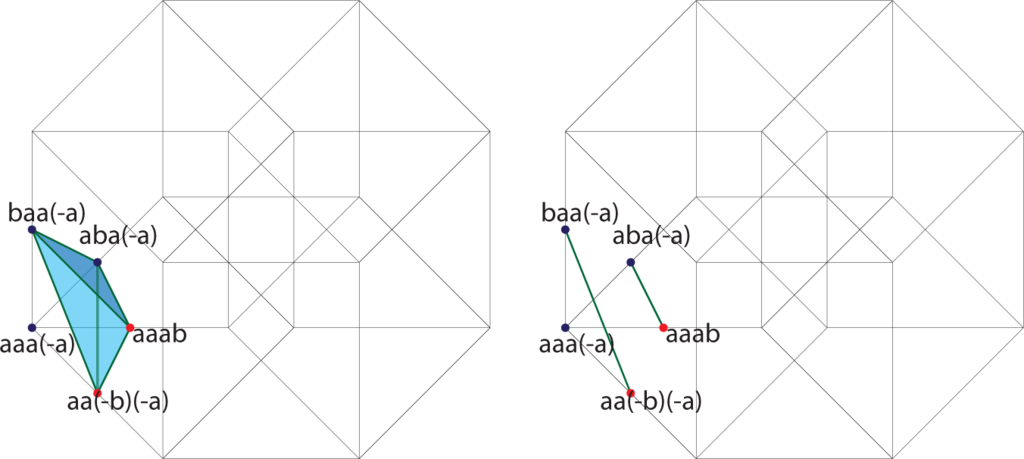

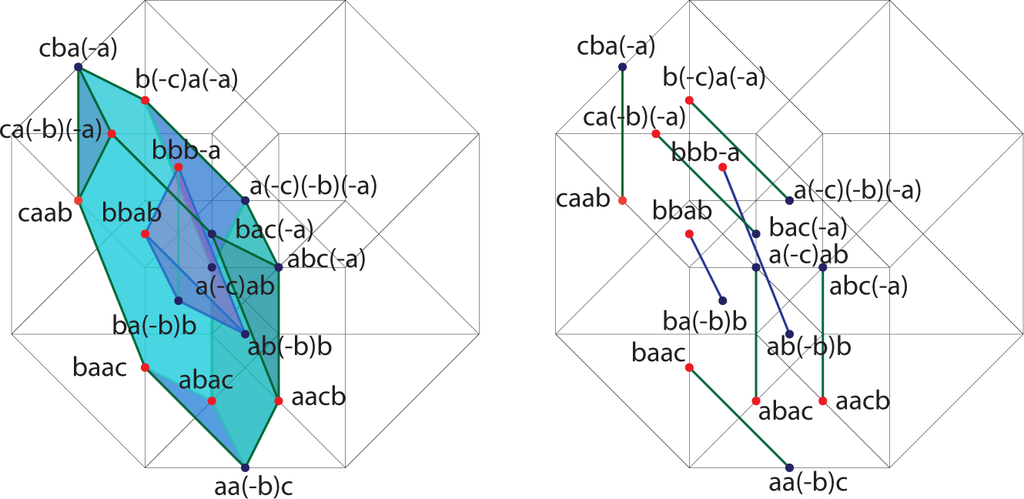

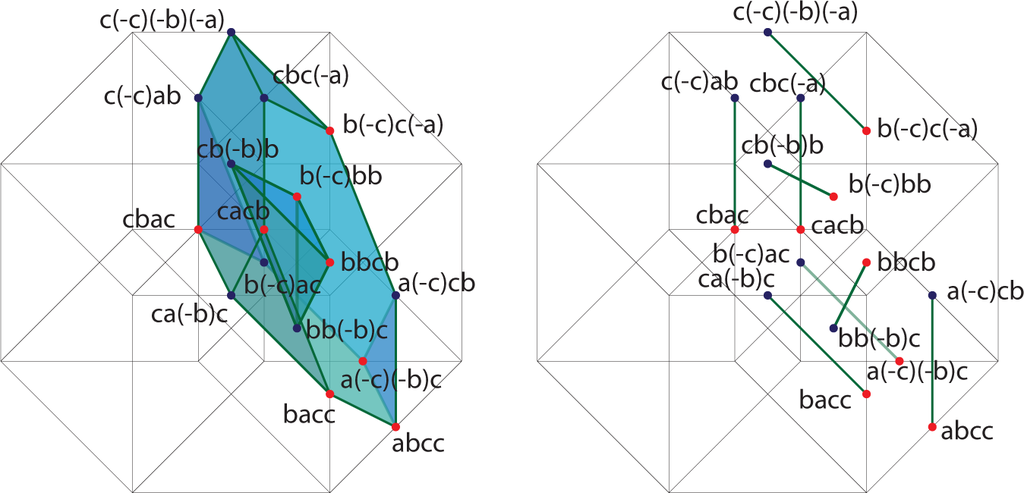

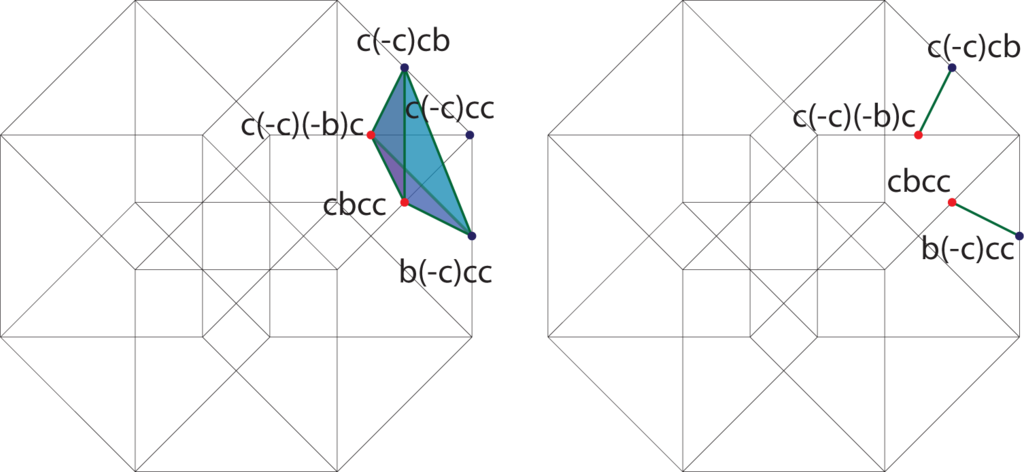

4. The Pythagorean Theorem
The illustration in Figure 17 schematizes a proof of the Pythagorean theorem. Four right triangles with legs of length x and y and hypotenuse z are arranged to nearly fill a square whose edge length is z. The missing piece is a square of size (y − x) × (y − x), where, by convention, x ≤ y ≤ z (in the case for which x = y, the central square is empty). Let us call the copies of the triangles NE, SE, SW and NW, depending on their positions with respect to the cardinal directions. The NE and SW triangles are reassembled to form a rectangle of size x × y; similarly the NW and SE triangles form a congruent rectangle. In the reassembly, the triangles are only moved by translation. Then, the central square is appended. The union on the central square and the NW to the SE rectangle together with a portion of remaining rectangle form a square of size y × y. The remaining piece of the other rectangle is a square of size x × x. Thus, the area z × z can be cut into two squares of size x × x and y × y.

Now, consider a pair of right triangles. The first has legs of length x and y with x ≤ y. The second has legs of length u and v with u ≤ v. The length of the hypotenuses are z and w, respectively. We will now consider a hyper-rectangle Rzzww = [0, z] × [0, z] × [0, w] × [0, w], and decompose both the (z × z) and (w × w) squares into five pieces (four triangles and one small square) as in the proof of the Pythagorean theorem. The hyper-rectangle Rzzww is cut into 25 pieces. Two views of this object are illustrated in Figure 18. We encourage the reader to attempt a cross-eyed stereopsis to imagine some of the depth in this illustration.
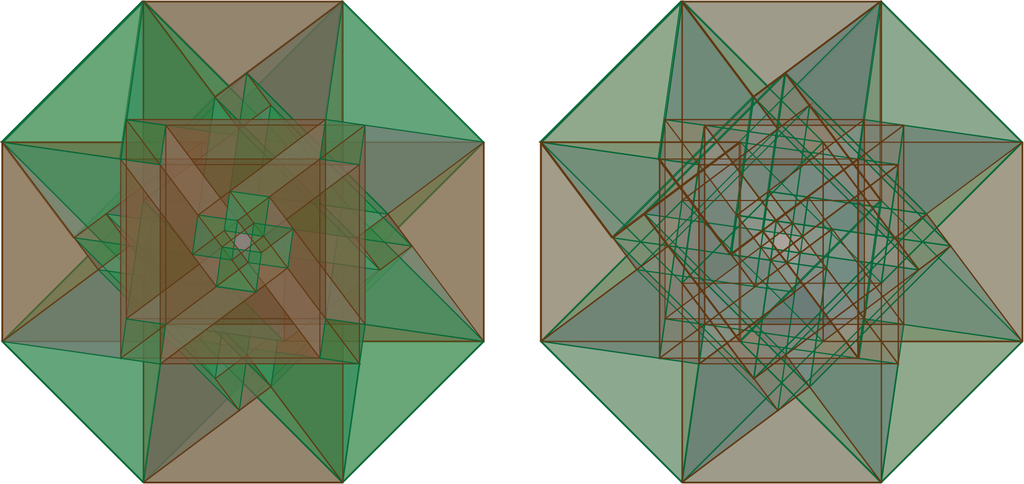
In our illustrations, we project the zz directions into the horizontal and vertical directions of the plane defined by the paper (computer screen) and project the ww directions into directions at a 45° angle. In this way, we will speak of the N, S, E and W triangles and the NW, NE, SW and SE triangles. Furthermore, we will consider the cardinal directions first and the off-cardinal directions second. Then, in Figures 19–23, we illustrate the 25 pieces that will result as planar projections of solids of the form (triangle × triangle), (triangle × square), (square × triangle) and (square × square).
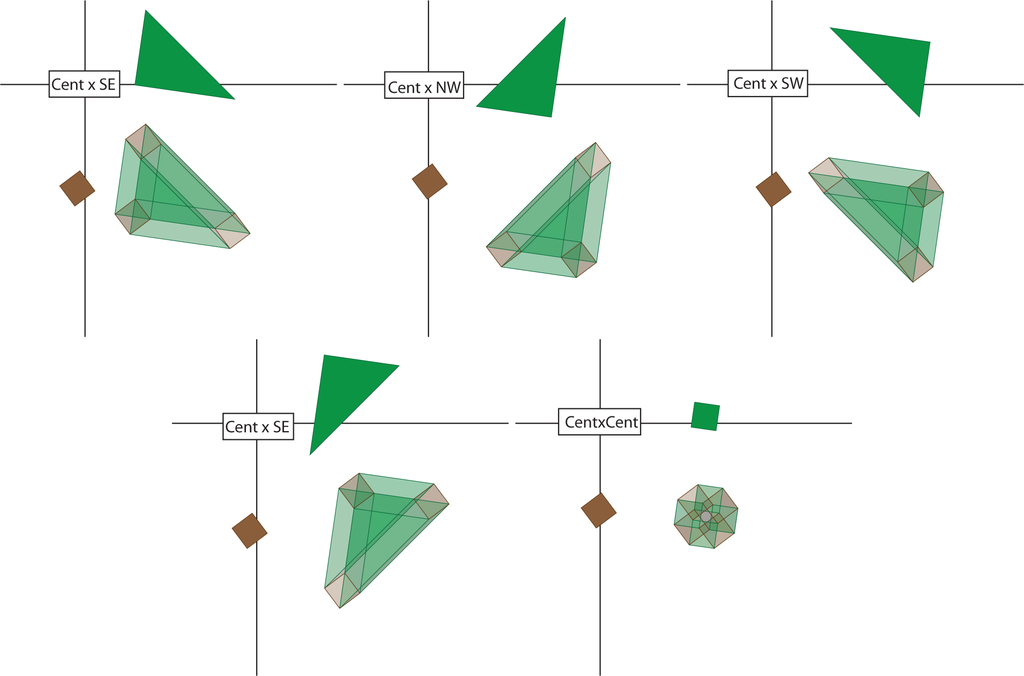
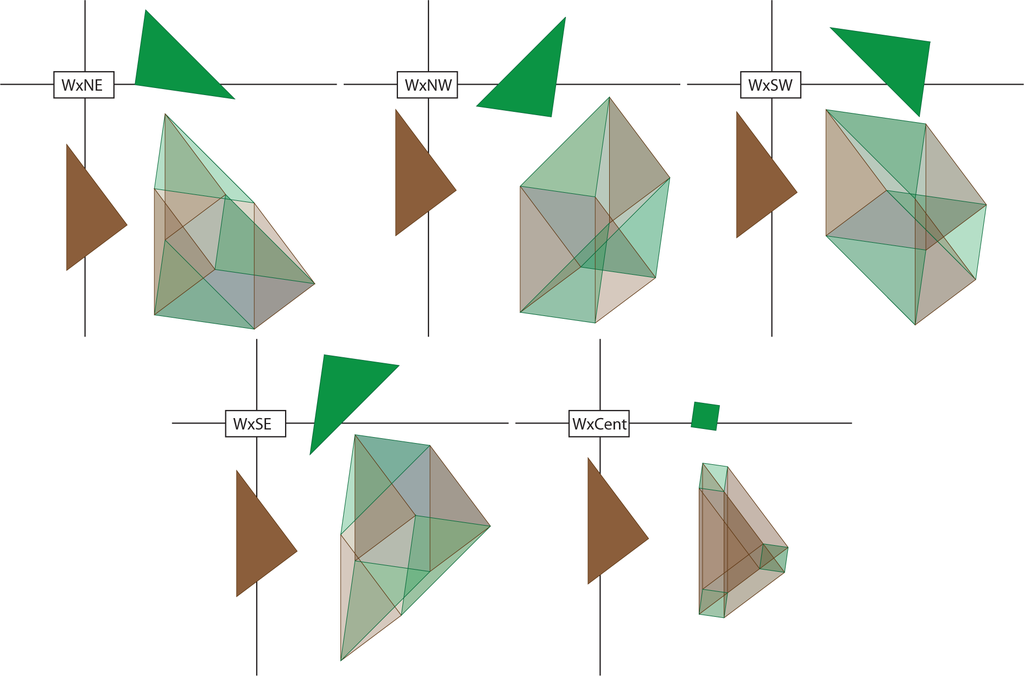
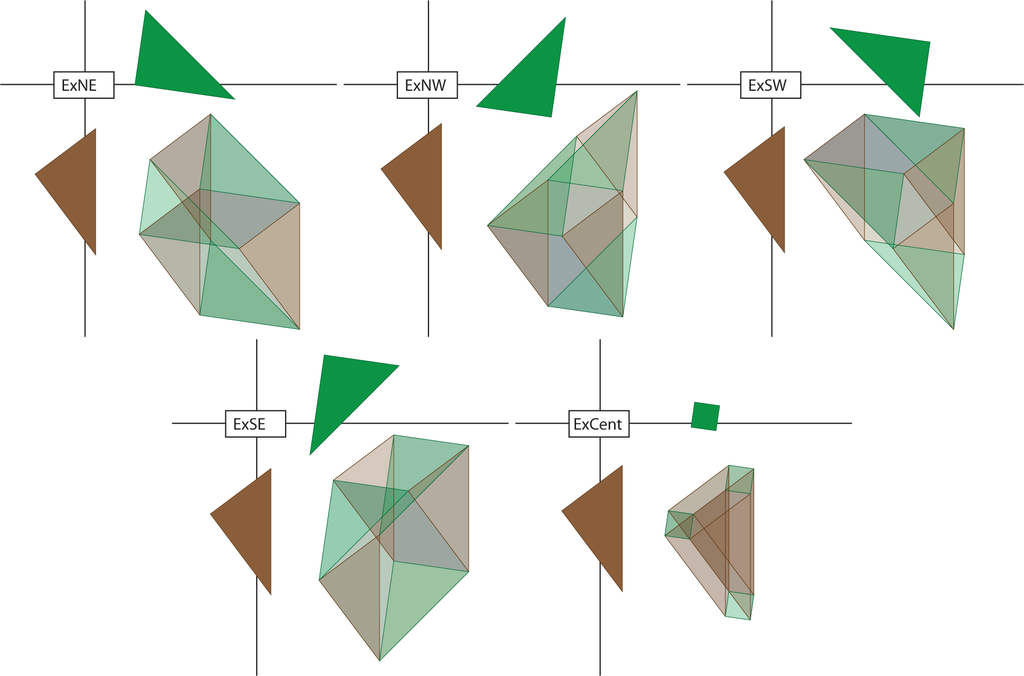
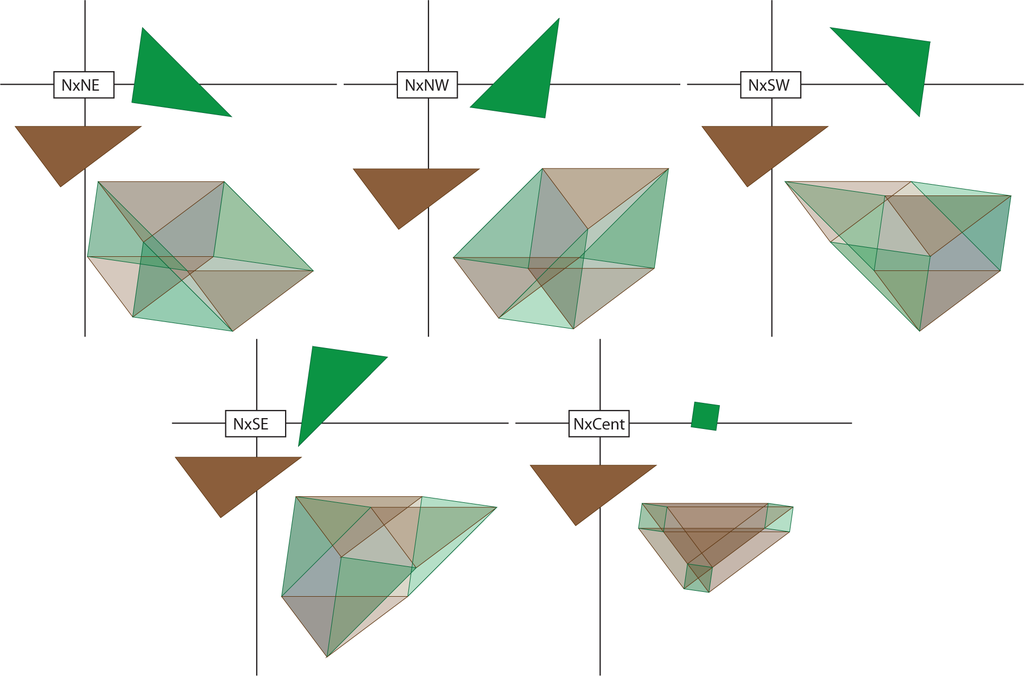
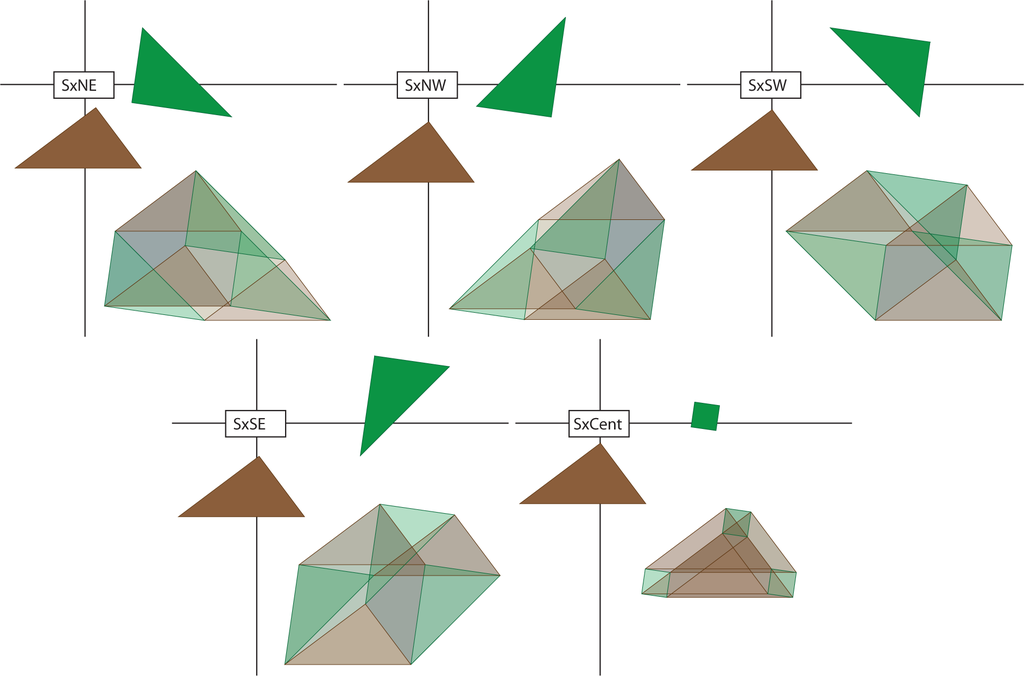
Next, we reassemble these pieces following the reassembly of the Pythagorean theorem. Some of these reassemblies are illustrated in Figures 20–23. In Figure 24, the green northeast/southwest and northwest/southeast triangles times east and west brown triangles are reassembled into two (green) rectangles times (brown) triangles. A similar reassembly occurs in Figure 25. Figure 26 indicates the product of a small green square with each of the (brown) north/south and east/west rectangles and the small brown square. There is a similar figure (not drawn) that is the product of the small brown square and each of the two green rectangles. The small green square times small brown square is only used once. Figure 27 indicates how triangles times rectangles are reassembled to be rectangles times rectangles. Then, in Figure 28, the small central hypercube is placed in the one-skeleton of the full reassembly. Figure 29 demonstrates the outlines of the four hypercubes fit into this conglomeration. Finally, Figure 30 shows all four of these square-by-squares inside this conglomeration.




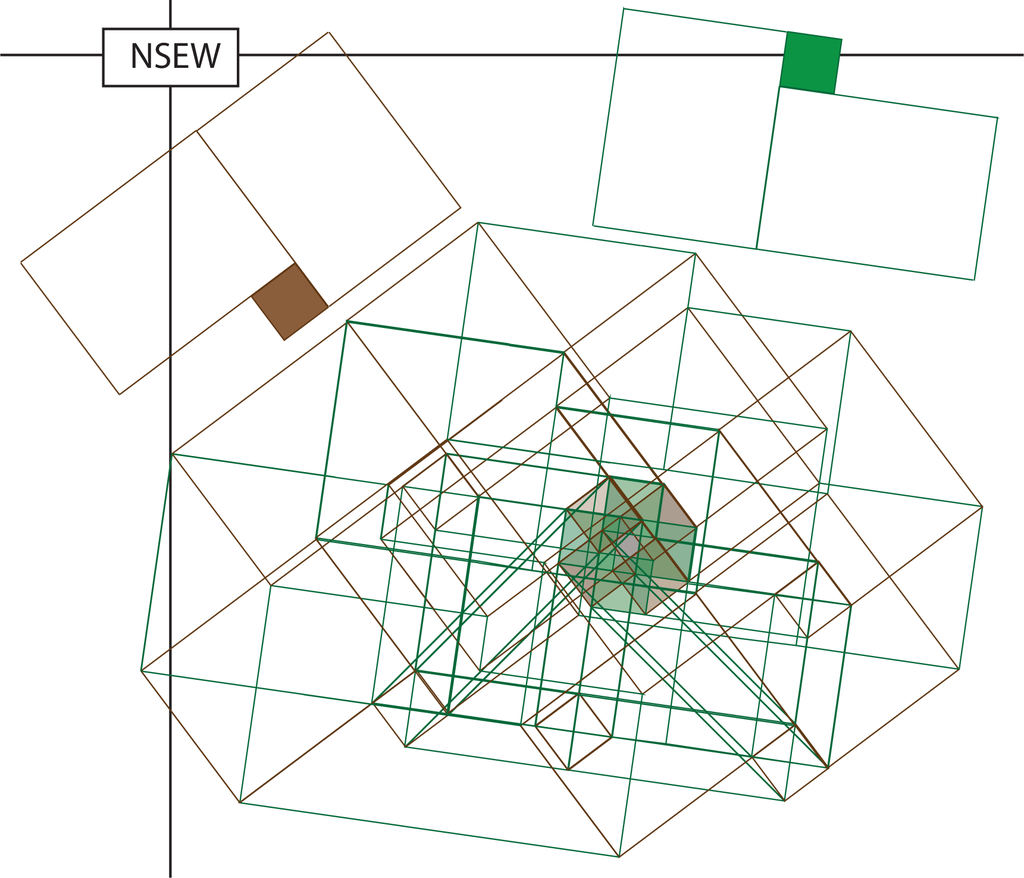
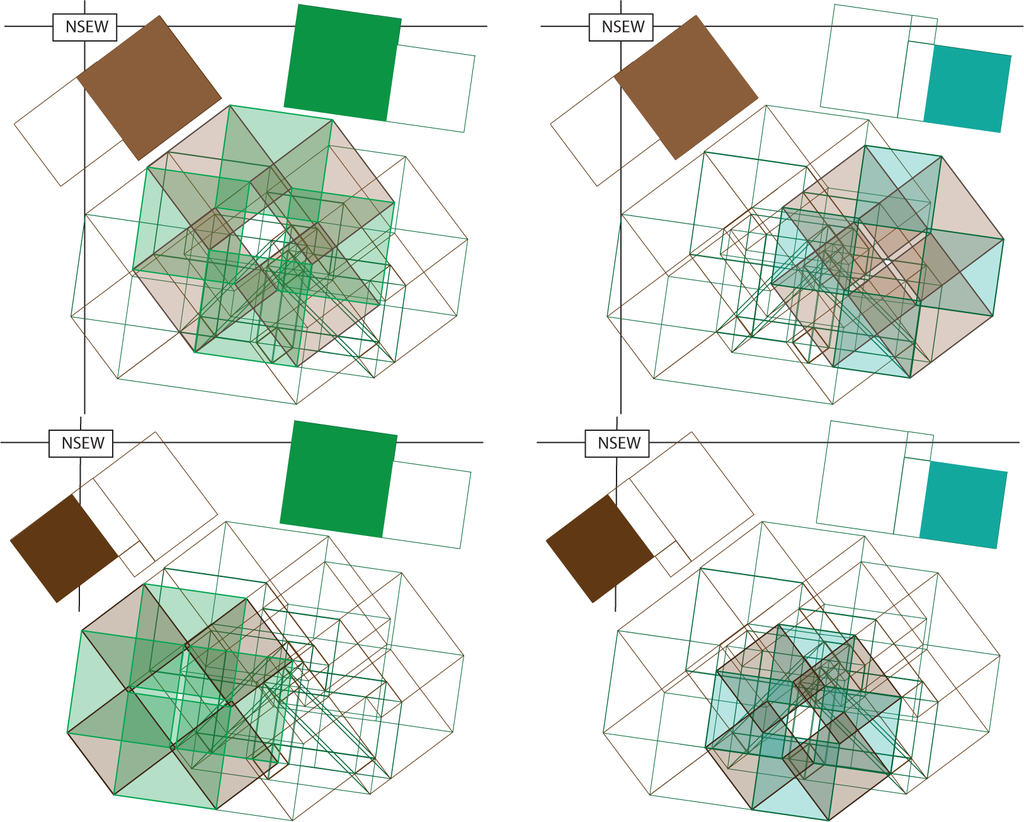
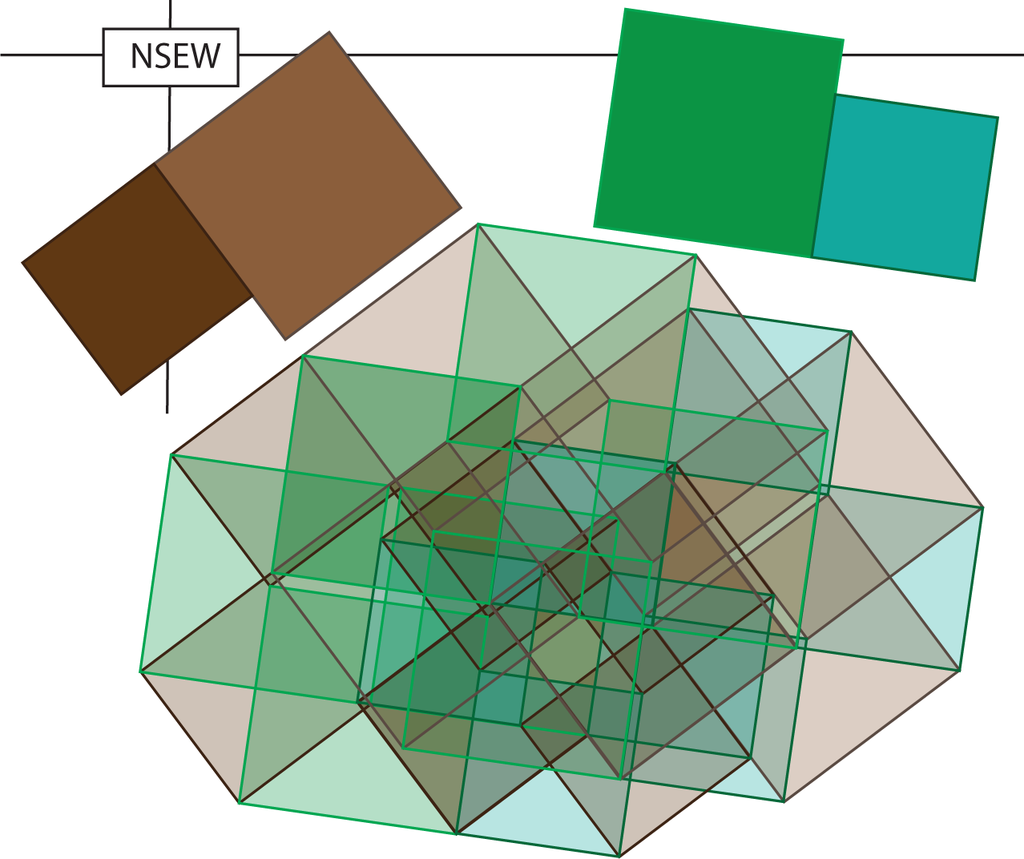
In this way, we have illustrated that the algebraic identity:
We apply these decompositions to the factors a4, b4 and a2b2 in the expansion of:
Here, a2 = r2 + s2 and b2 = s2 + (p − r)2. In addition, the terms of the form a2c2 and b2c2 can be reformed by decomposing a2 or b2 into the five pieces in the proof of the Pythagorean theorem and taking the Cartesian product of each with a square of area c2 = p2. When the five pieces are reassembled as a union of two squares, the resulting four-dimensional solids are also reassembled.
5. Products of Sums and Differences of Squares
In Figures 31 and 32, we indicate that products of the form (x2−y2)(x2−y2) and products of the form (x2 + y2)(z2 + w2), when thought of as hyper-volumes of four-dimensional solids, can be reassembled into hyper-rectangles whose volumes are the expected terms:
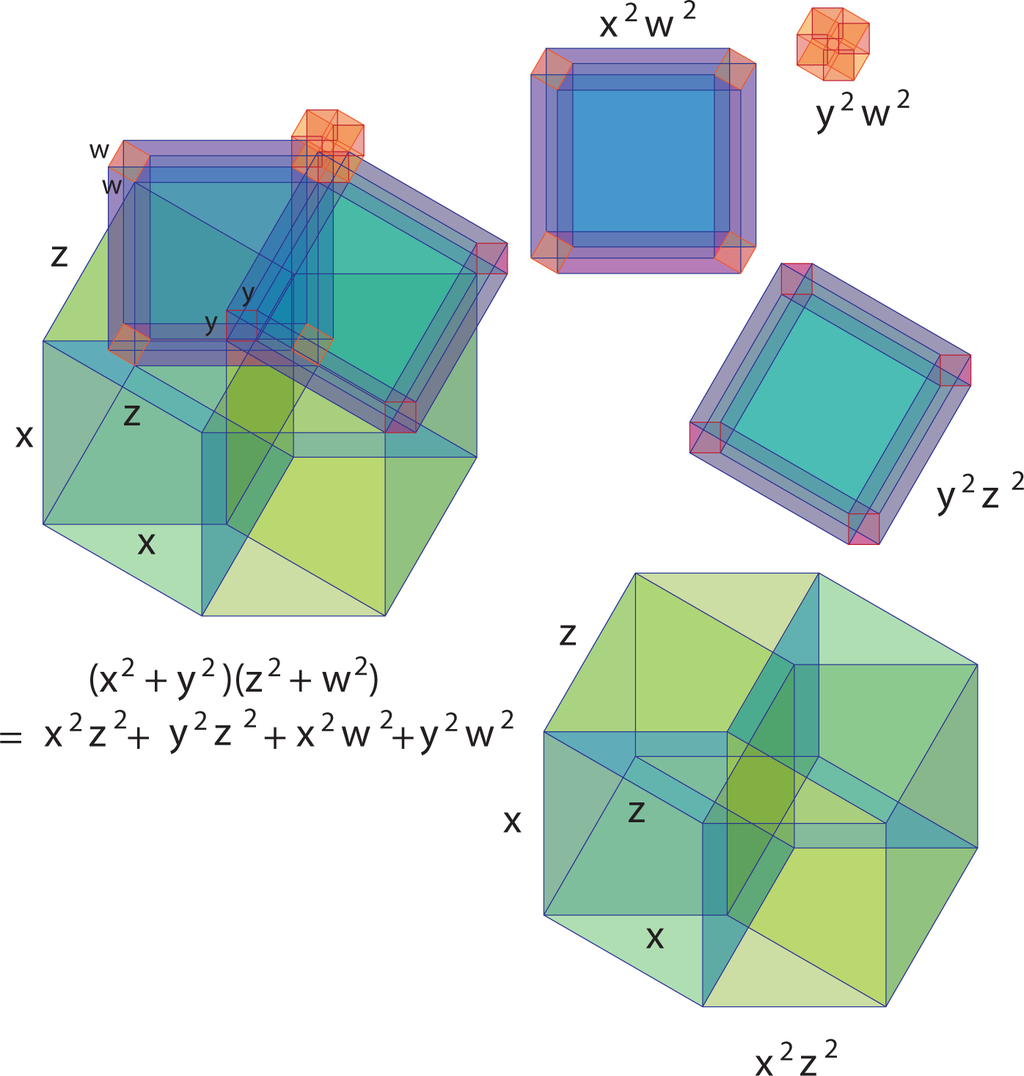
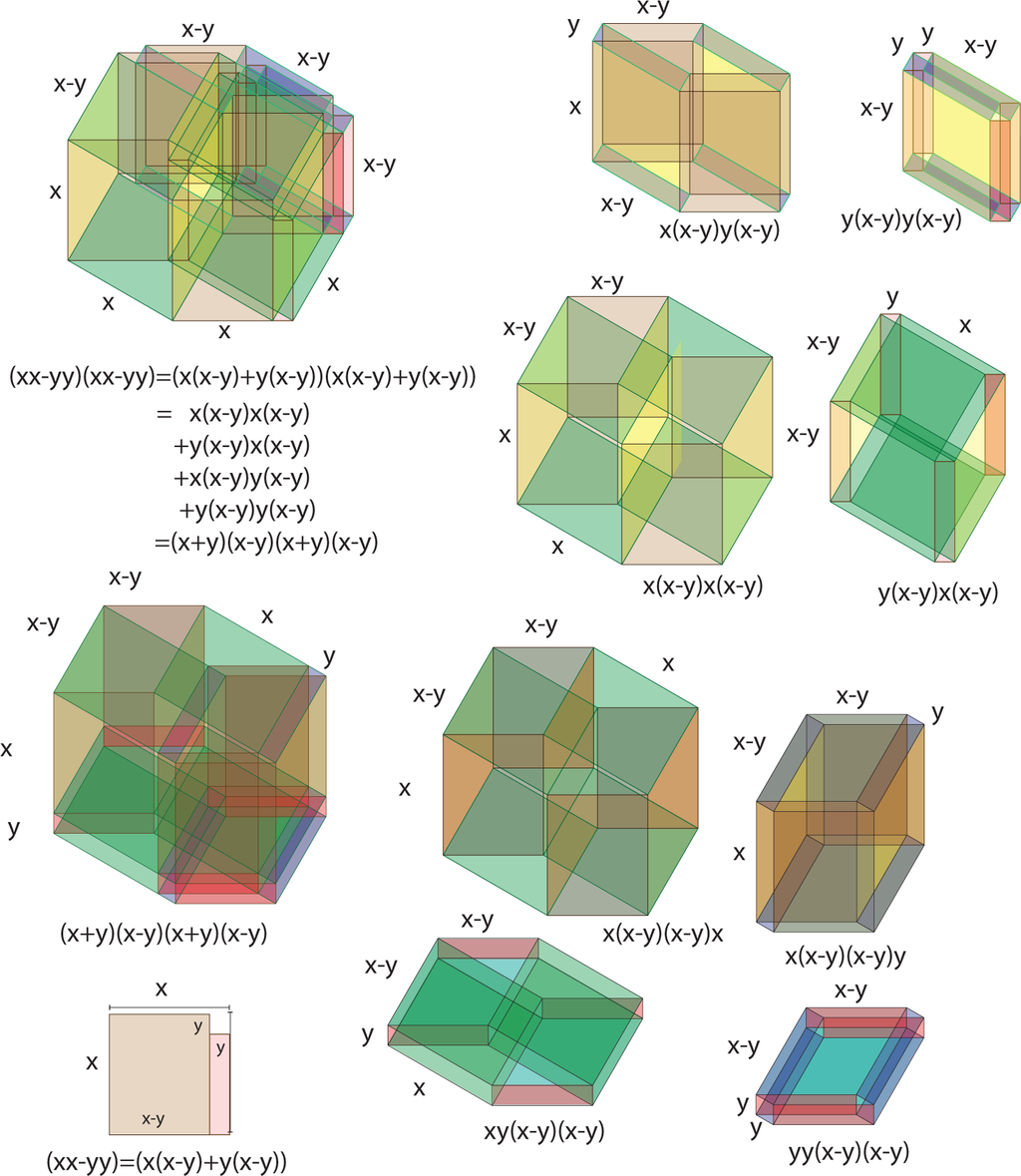
More specifically, in Figure 31, we have illustrated the two-dimensional projection of a figure from four-space that is constructed by taking the Cartesian product of a planar figure with itself. The planar figure is the union of two squares joined at a vertex. The algebraic expansion above corresponds to the decomposition of this four-dimensional figure into four hyper-rectangles of four-dimensional volumes x2w2, y2w2, y2z2 and x2z2.
In the case of the product of a difference of squares with itself, we could use the same figure provided that we interpreted some edge lengths as being negative. However, we can be more descriptive in Figure 32. Start from a planar figure that is constructed by cutting a small square from the northeast corner of a given square, as indicated in the lower left of the figure. Such a figure superficially resembles the geometry of the state of Utah. This figure can be decomposed as the union of two rectangles of size (x − y) × x and size y × (x − y). When we take the Cartesian product of such a planar region with itself, it projects to the illustration in the upper left of the corner. Equationally, the expression (x2 − y2) is expanded below that illustration. Meanwhile, each term in that expansion is illustrated to the right with the lengths of each edge indicated. In the lower portion of the figure, those same four pieces are illustrated with the regions of sizes (x − y) × y × y × (x − y) and x × (x − y) × (x − y) × y × x rotated in the set of illustrations to the bottom right. These are then reassembled to form a four-dimensional hyper-solid of size (x + y) × (x − y) × (x + y) × (x − y).
Such multiplications and factorizations were used in the last stages of the original algebraic computation to illustrate that
6. The Left-Hand Side of the Formula
Consider now the proof that the area of an arbitrary triangle as indicated in Figure 1 is p · r/2. The triangle is duplicated and reflected along a horizontal line, and these two copies of the original triangle are joined to create a parallelogram. Thus, twice the area of the triangle is the area of the parallelogram. Meanwhile, the parallelogram is scissors congruent to a rectangle.
If we consider the four-dimensional figure that is a parallelogram-times-parallelogram, then it can be decomposed into four copies of a triangle times a triangle. The decomposition is analogous to that which is depicted in Figure 6, so we do not indicate a new proof. In the former case, the triangles were right triangles. In general, this decomposition can be composed with a linear map from the rectangle-times-rectangle to the parallelogram-times-parallelogram.
In Figure 33, the decomposition of a parallelogram into a right triangle and a trapezoid is lifted into four-space as the decomposition of a parallelogram-times-parallelogram into four pieces: triangle-times-triangle, triangle-times-trapezoid, trapezoid-times-triangle and trapezoid-times-trapezoid. In Figure 34, these same four pieces are reassembled to fill a rectangle-times-rectangle.
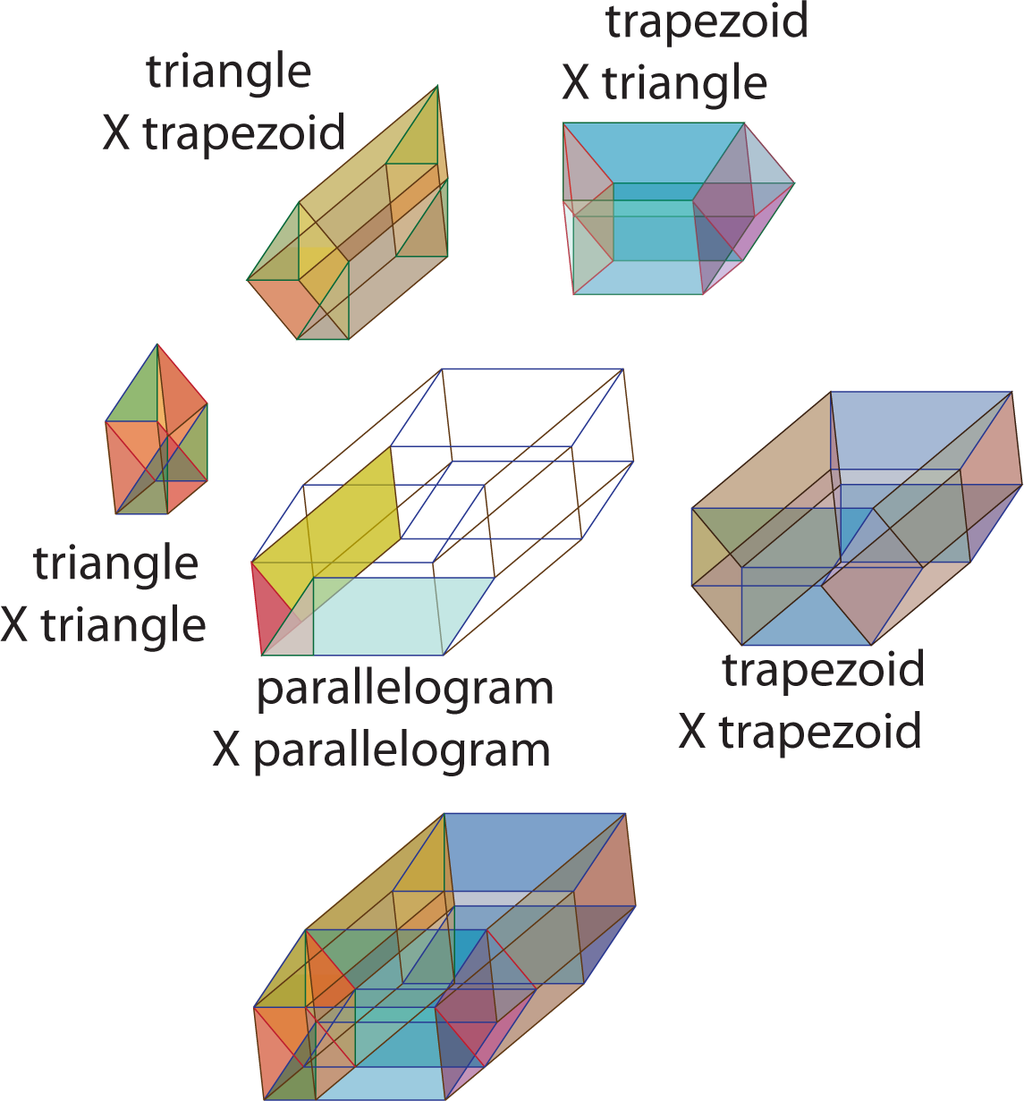
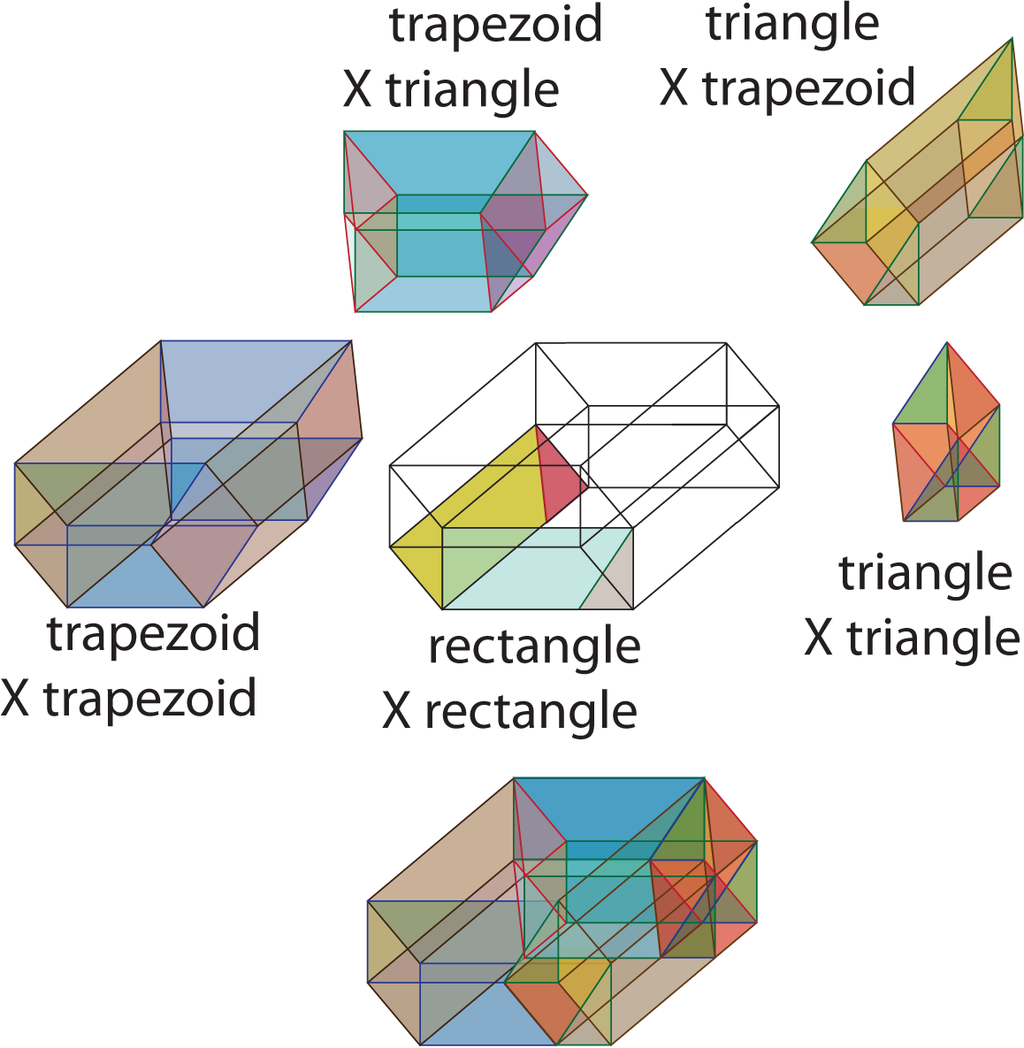
The left-hand side of Heron’s formula is the quantity 4p2r2. Sixteen copies of the original triangle times itself are reassembled into four copies of a rectangle-times-rectangle where the rectangle is of size p × r. Thus, the sequence of equalities:
Our four-dimensional geometric proof is complete.
7. Conclusions
Even after more than two and a half centuries of study, many people, including many outstanding mathematicians, have not developed an intuitive grasp of the elements of four-dimensional geometry. Of course, many of us have a more esoteric understanding of higher geometry that is facilitated by our deep understanding of linear algebra and differential forms. Our purpose here has been to demonstrate with two-dimensional projections and with analytic descriptions that many aspects of four-dimensional geometry can be understood. In addition, we have indicated that a number of combinatorial structures and identities are more deeply understood in terms of aspects of higher dimensional geometry.
Therefore, while an algebraic proof of Heron’s formula is tedious, yet conceptually simple, a more geometric proof that depends on the geometry of four-spacial dimensions removes some aspects of the tedium. One can envision the pieces fitting tightly together.
Still, there is a cautionary statement to be made. We only perceive two dimensions. Those of us who are sighted see the world projected onto our retinas. As I type these lines, my hands feel the surface of a desk that I presume to be solid. A four-dimensional hyper-solid has a boundary that is three-dimensional. I can only imagine the surfaces of these pieces. As the four-dimensional hyper-solid is projected to three-space, its boundary overlaps in the same way that a ball or orange projects to my eye and appears to be a disk. The front and the back of the ball veil the inner structure.
When we use a temporal metaphor to describe the space-time of the room in which we sit, the authors move within the confines of this 10 × 11 × 10 cubic foot room for a period of, say, one hour. The walls, floor and ceiling of the room form a substantial portion of the boundary as they evolve in time. The“us-then” and the “us-now”, that is the interior of the room before the paragraph was written and the interior of the room as the paragraph ends, form the rest of the boundary. Our discussion and our gesticulations in completing this last paragraph and all of the space around us (as a small part of space-time) forms the interior of this hyper-cube of a size of 1100 ft3/h.
Neither the space-time metaphor nor the projection method produce the full richness of a four-dimensional entity. However, together, they can be used to develop our understanding.
Acknowledgments
The initial work for this project was conducted when the second author was a UCUR (University Committee for Undergraduate Scholarship) student at the University of South Alabama. It appeared in [8], but we felt that the pictures and our techniques deserved a wider audience. We would like to thank Dror Bar-Natan, Abhijit Champanerkar, Dylan Thurston and the faculty at the University of South Alabama Department of Mathematics and Statistics for valuable conversations.
Author Contributions
The authors contributed equally to this work.
Conflicts of Interest
The Authors declare no conflict of interest.
References
- Struik, D. A Concise History of Mathematics, 4th ed; Dover; Mineola, NY, USA, 1987. [Google Scholar]
- Wikipedia: Heron’s Formula, Available online: http://en.wikipedia.org/wiki/Heron%27s_formula accessed on 28 April 2015.
- Wikipedia: Squared Triangular Number, Available online: http://en.wikipedia.org/wiki/Squared_triangular_number accessed on 28 April 2015.
- Carter, J.S.; Champanerkar, A. A geometric method to compute some elementary integrals, 2006, arXiv, p. math/0608722. [math.HO]. arXiv.org e-Print archive. Available online: http://arxiv.org/pdf/math/0608722 accessed on 28 April 2015.
- Barth, N.R. Computing Cavalieri’s Quadrature Formula By a Symmetry of the n-Cube. Am. Math. Mon. 2004, 111, 811–813. [Google Scholar]
- Benko, D. A New approach to Hilbert’s Third Problem. Am. Math. Mon. 2007, 114, 665–676. [Google Scholar]
- Dehn, M. Ueber den Rauminhalt. Math. Annalen 1901, 55, 465–478. [Google Scholar]
- Carter, J.S.; Mullens, D.A. Heron’s Formula from a 4-Dimensional Perspective, Available online: http://www.mi.sanu.ac.rs/vismath/carter2011mart/Carter.pdf accessed on 28 April 2015.
© 2015 by the authors; licensee MDPI, Basel, Switzerland This article is an open access article distributed under the terms and conditions of the Creative Commons Attribution license (http://creativecommons.org/licenses/by/4.0/).